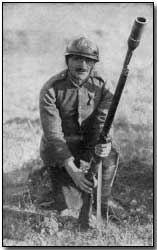Who's Who - Sir William Mills
 Sir William Mills
(1856-1932) was the British developer of the Allies' most ubiquitous
hand
grenade of World War One, the 'Mills bomb'.
Sir William Mills
(1856-1932) was the British developer of the Allies' most ubiquitous
hand
grenade of World War One, the 'Mills bomb'.
The son of a Sunderland shipbuilder Mills spent a period at sea following an apprenticeship as a marine engineer. An inveterate inventor from an early age, he quickly established a notable reputation in the field of metallurgy - he built the first aluminium foundry in Britain - and became well known for the design and manufacture of golf clubs.
However Mills made his name with the rapid onset of trench warfare during World War One. Recognising the high value placed upon the use of hand grenades in the confined space of a trench he resolved to design a grenade for use by Sir John French's British Expeditionary Force (BEF) in France and Flanders 1915
There were innumerable types of grenade designed and produced during the war - well over 50 - but Mills designed a series that endured, and which retains a popular awareness even today.
Actually referred to officially as 'No. 5', the Mills bomb was introduced in May 1915 and became the dominant British grenade for the remainder of the war. Weighing 1.25 lb, the Mills bomb's exterior was serrated so that when it detonated it broke into many fragments: thus, a fragmentation bomb.
To use the Mills bomb the thrower first removed the safety pin while holding down the strike lever beneath it. When the grenade was actually thrown the strike lever ejected and a four-second fuse was set off.
 British
and Empire soldiers were instructed to lob the Mills bomb using a throwing
action similar to bowling in cricket. Classes were taught instructing
soldiers how best to do this.
British
and Empire soldiers were instructed to lob the Mills bomb using a throwing
action similar to bowling in cricket. Classes were taught instructing
soldiers how best to do this.
The Mills bomb was improved upon in 1917 with a revised model, No. 36M. This was filled with explosive and then dipped in shellac, which served to seal the grenade and thus prevented rapid deterioration (markedly reducing the number of 'dud', i.e. ineffective, devices). Its base plug was also strengthened, for use on a rifle discharger (when its fuse was lengthened to a seven-second delay).
Transported in boxes of twelve with detonators carried separately, British soldiers found that they could not readily carry multiple Mills bombs on their person on account of their closer fitting uniforms. Their Australian allies, with looser clothing, could carry around half a dozen Mills bombs with reasonable comfort. The British took to carrying green canvas buckets filled with Mills bombs (up to 24 at a time) for use in an attack.
The detonators were supposed to be attached to the actual grenade before the boxes of grenades reached the front line. It was not unknown however for a box of Mills bombs to be opened for use only to discover that they were without their necessary detonators.
It has been estimated that during the course of the war approximately 70 million Mills bombs were thrown by the Allies, with perhaps 35 million other types; a testament to the overwhelming popularity of the Mills bomb itself.
The Mills bomb was further adapted for use as a rifle grenade.
After the war Mills received a knighthood for his services in 1922. He died in 1932.
By 1918 the percentage of women to men working in Britain had risen to 37% from 24% at the start of the war.
- Did you know?
